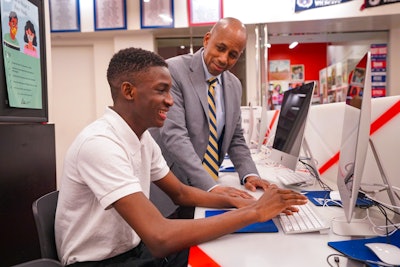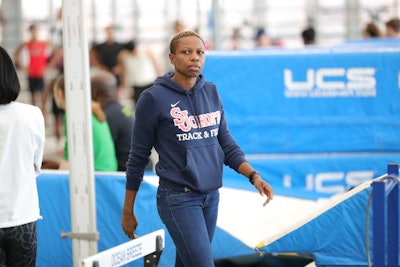Organizations rooted in sports incorporate educational curriculum that helps participants be better prepared for higher education.
“The main way that we can help prepare athletes for college is to [make them] really good gymnasts, which means they are focused, and they understand hard work — all of the things that help them become good students,” says former rhythmic gymnast Wendy Hilliard, who established the Wendy Hilliard Gymnastics Foundation (WHGF) in 1996.
Based in New York City and Detroit, WHGF provides low-cost and free gymnastics classes for girls and boys 18 months and up. It trains competitive rhythmic, artistic, tumbling, and trampoline gymnasts. There are also reading and nutrition workshops.
“What we found is that the kids that we train do really well when they go on to college,” says Hilliard. “They also have something they can teach, instead of having to earn money with a minimum wage job.”
Access to sports
Growing up in Brooklyn, New York, Nzingha Prescod initially didn’t see many sports options, but at age 8 she found her way to The Peter Westbrook Foundation, which offered fencing to New York City kids. She discovered a love for the sport that led her to competitive fencing, Columbia University, international competition, and two Olympic Games.
“I had an opportunity to be around greatness and to aspire for greatness,” says Prescod, the first Black woman to win an individual medal at the Senior World Championships as well as a team gold medal at the 2018 World Championships. “It was a lot of character development in terms of discipline and learning commitment. I always tell people you have to learn how to work hard.”
In November 2021, Prescod launched The PISTE (Prescod Institute for Sport, Teamwork, and Education) Fencing Academy based in Flatbush, Brooklyn, which teaches the sport of fencing and its principles of discipline, strategic thinking, problem-solving, and fitness. It also seeks to improve access to quality education for kids in under-resourced communities. Participation is currently free with no required cost to families.
PISTE Fencing Academy is a developmental program with participants, ages 8-12. As they progress in the sport, they retain a sense of community and access to opportunities in competition, travel, and networking. Prescod also conducts Fencing in the Park, a weekly summer series for children, ages 5-12, introducing them to fencing. Some participants go on to join the academy.
The Armory Track is a renowned indoor track and field facility in Washington Heights, Manhattan in New York. It is a training site for people of all ages. Through its Armory Foundation, it motivates youth from around the city by offering competitive track and field along with educational programming and co-curricular activities.
Educational programming
 Armory College Prep helps student-athletes attain a college degree at no cost to participants.
Armory College Prep helps student-athletes attain a college degree at no cost to participants.
ACP is open to fourth through 12th graders who have trained or competed or currently train at the facility. Elementary and middle schoolers must reside in Washington Heights (where Armory Track is located), Harlem, or Inwood. Programming for fourth and fifth graders fosters a love of literature and technology. Middle schoolers receive STEAM (science, technology, engineering, arts and math) curriculum and high school application guidance.
“We look for schools that have an established track team and a robust academic life,” says Finkel.
Ninth through 12th graders receive academic advancement, individualized college counseling, tutoring, essay writing guidance, SAT prep, exposure to colleges, and career exploration with some college visits. Finkel notes, participants mostly aren’t students aiming to compete in track and field at the Division I level, but some do want to compete in college. “We have sent numerous kids to Williams College (a Division III school),” says Finkel.
Rising high school seniors spend the summer before senior year working on college applications with an eye toward at least one early application. NYC Mayor Eric Adams has promoted and increased funding for the Summer Youth Employment Program (SYED), helping youth ages 14-24 get summer paid job experience. After being turned down by the Department of Youth and Community Development, Finkel found funders to pay the students for their summer participation, which she says is working toward their future.
“They showed up every day on time and completed their work just like it was a job, and we paid them $2,000 each for the summer so that we could make sure they weren’t losing out on taking a SYED job,” says Finkel.
The PISTE Fencing Academy fosters the aspiration to academic excellence, which includes providing academic tutoring to participants. The academy has partnered with the Stuyvesant High School Honors Society — Stuyvesant is a highly selective public high school — and other outlets to provide academic support and mentoring. There are also chess lessons each week as well as music and art. Information is provided on how to apply to New York City’s elite public high schools.
Acrobatics and tumbling are emerging in collegiate sports. Hilliard says that athletic scholarships in artistic gymnastics tend to go to elite gymnasts who’ve competed at the highest level. When WHGF coaches see kids who have that potential they will do their utmost to connect them with an elite gymnastics school in New York that will give them a scholarship and put them on the path to a collegiate athletic scholarship.
“We have had a couple of gymnasts that went on to compete at Division II,” says Hilliard. “I think acro-tumbling is going to be our mark because we have such good tumblers and our kids are really well trained. Now, we are getting into the recruiting process and working with our parents to understand that.”
Tom Kovic, founder and principal advisor of Victory Collegiate Consulting and former head gymnastics coach at University of Pennsylvania, gave WHGF parents a free session on college recruiting. Also, one of the parents, Alina Sivorinovsky Wickham, an author and parent workshop leader, helps fellow parents with the New York City school process.
College success
“In fencing, you have to make split-second decisions that aren’t always instinctive,” says Prescod. “It takes a lot of body and mind awareness and self-control to master your reactions in those quick and tense moments where there’s a lot of pressure. It develops something I call the executive mind.
“Training in the sport of fencing produces great mental acuity and decision-making skills,” she adds. “A lot of the training is focused on discipline, structure, being attentive. … You can use those strategies anywhere.”
Since its inception, ACP has helped participants receive over $10 million in college scholarship funds. They have been accepted at such prestigious institutions as Brandeis, Brown, Dartmouth, Emory, Howard, NYU, and Temple.
“Their high schools will help them with applications to public institutions [like CUNY or SUNY],” Finkel says. “Armory College Prep is supposed to open a world view that they don’t have access to. In a regular year where the schools are allowing visits, we try to get the kids to 12 colleges…so they can see themselves on a college campus.”
 Aliann Pompey
Aliann Pompey
Today, as a Division I collegiate coach, Pompey sees numerous student-athletes who’ve gone through college access programming. Also, collegiate athletic departments have stepped up their efforts toward retention and student success. In her 8.5 years at St. John’s, there have been two members of the track and field team who participated in ACP. Both graduated.
“I don’t necessarily look for a student-athlete that has been in a program like [ACP], but it helps because I know they have a solid background,” says Pompey. “For a student-athlete that doesn’t have that experience, it’s a lot more background work because they’re going to have a lot of questions and there’s no context for a lot of the application paperwork that they’re going to have to do.”
“We were really mindful of putting them in an environment where they’d succeed,” she adds. “We were not just a college access program. We wanted to be a college success program.”





















